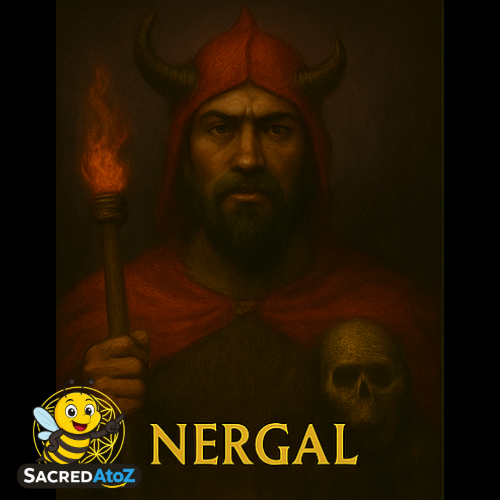Sumerian
Anunnaki Gods List:
The Sumerian culture stands at the dawn of recorded civilization—the first to write the names of gods upon clay, to measure time, and to give divine order to the cosmos. In the fertile plains of Mesopotamia, between the Tigris and Euphrates, the Sumerians built shining cities dedicated to their gods, seeing in every harvest, flood, and star the presence of a living divinity. To them, the universe was not chaos but a sacred kingdom of balance, ruled by the great gods who shaped heaven, earth, and destiny itself.
Origins and the Birth of the GodsBefore the beginning, there was only the Primeval Sea—a boundless abyss known as Nammu, the cosmic mother from whom all things were born. From her arose the twin principles of heaven and earth: An, the Sky Father, and Ki, the Earth Mother. Their union gave birth to Enlil, the Lord of Air, who separated heaven from earth and brought the world into being. Through this sacred act, the universe gained structure: heaven above, earth below, and the subterranean waters beneath all.
From the divine assembly of An and Ki descended the pantheon of Sumerian gods—each governing an aspect of creation and civilization. The Sumerians saw their gods not as abstract forces but as living rulers whose temples were the axis of the world. Humanity’s duty was to serve them, to maintain balance through ritual and devotion, ensuring the cosmic order would endure.
The Great Gods of Sumer- An (Anu): Supreme god of the heavens, father of gods, source of kingship and authority.
- Enlil: Lord of wind and air, giver of breath, power, and destiny; he separates heaven and earth and decrees the fate of all beings.
- Enki (Ea): God of wisdom, water, and creation—he who brought civilization to humankind and taught the arts of writing, craft, and law.
- Ninhursag: Great Mother and goddess of the mountains and fertility; she formed the bodies of men and animals from sacred clay.
- Inanna (Ishtar): Goddess of love, war, and the morning star—bringer of passion, justice, and transformation.
- Utu (Shamash): God of the sun and truth, judge of gods and men, shining light upon the righteous and exposing deceit.
- Nanna (Sin): God of the moon, keeper of time and divine cycles, his waxing and waning marking the rhythm of fate.
- Ereshkigal: Queen of the Underworld, ruler of the Great Below, guardian of the dead and the laws of mortality.
- Dumuzi (Tammuz): Shepherd god and consort of Inanna, whose death and resurrection mark the seasons of the earth.
The Sumerians believed that the gods shaped humankind from clay mixed with the blood of a divine being, to relieve the gods of their labor. Thus, humans were created to serve the divine through work and worship—to till the fields, build temples, and offer praise. But this service was sacred, not servitude: by honoring the gods, humanity sustained the universe itself.
Each city was under the patronage of a deity—Enki at Eridu, Inanna at Uruk, Enlil at Nippur, Nanna at Ur. The temple was not only a house of worship but the living body of the god on earth, a center of spiritual, political, and cosmic power.
Myths of Life, Death, and Power- The Descent of Inanna: The goddess of love and war descended into the underworld to confront her sister Ereshkigal, was stripped of her powers, killed, and then resurrected through divine intervention. Her journey symbolizes death, renewal, and the balance of power between life and shadow.
- The Enuma Elish (later Babylonian form): The Sumerian roots of the cosmic battle between order and chaos—where creation emerges from divine struggle and the shaping of the heavens from the deep.
- The Flood of Ziusudra: An early prototype of the later Noah tale—Ziusudra, warned by Enki, builds a great boat to survive the flood sent by Enlil, carrying life into a renewed world.
The heart of every Sumerian city was the Ziggurat—a towering, terraced temple symbolizing the mountain that connected heaven and earth. The most sacred, the Etemenanki (“House of the Foundation of Heaven and Earth”), stood in Babylon, echoing the mythic Tower of Babel.
Priests and priestesses maintained the daily rituals: bathing the idols, offering food, incense, and music to sustain the gods’ presence. Festivals marked the cycles of planting and harvest, moon and sun—each reflecting the divine pattern woven into mortal life.
Symbols and Sacred Elements- Water: Sacred element of Enki—source of life, wisdom, and purification.
- Clay: Substance of creation from which gods formed humankind.
- Star of Inanna: The eight-pointed star symbolizing Venus, the goddess of love and war.
- Winged Disk: Emblem of divinity and kingship, representing celestial authority.
- Ziggurat: The earthly mountain linking gods and men, heaven and earth.
The Sumerians saw existence as a sacred balance between divine will and human duty. Every act—building, writing, farming, praying—was a form of worship, returning energy to the gods who sustained creation. Their vision of law, morality, and cosmic order laid the foundation for later Babylonian, Assyrian, Hebrew, and Greek thought.
Even after their cities fell, their myths endured: Enki became Ea, Inanna became Ishtar, and Ziusudra became Utnapishtim. Their language faded, but their gods live on in the roots of human consciousness, the first voices of civilization whispering through time.
To the Sumerians, the divine was not above the world—it was the world. Every river was Enki’s vein, every breeze Enlil’s breath, every spark of wisdom the whisper of the ancient gods who first taught humanity to dream.














